Invernahaille
|
 Posted - 15/05/2007 : 18:12 Posted - 15/05/2007 : 18:12
Ellerman Lines Big Four.
Introduction
This quartet was the largest passenger cargo liners of the once great Ellerman fleet, and they were able to make passage from London to Cape Town in 15 days. These all First Class attractive liners were considered some of the most luxurious round-Africa ships in their day, accommodating just 107 passengers, and were a considerable competition with the larger, famous Royal Rail Ships of the Union-Castle Line. The City of Port Elizabeth and her three sisters were known for their comfortable accommodations, having only single, and twin bedded cabins, although cabins some had an extra Pullman. All passenger cabins were located on A and B Decks, with those on A Deck being fitted with private bathrooms, whilst those on B Deck had shared facilities.
All Lounges were located on Promenade Deck, comprising of Drawing Room (forward), Foyer, Smoke Room, Writing Room, and the Verandah Café, which was also the dance venue. This delightful and cheerful room overlooked the swimming pool aft. Sports Deck was located directly above Promenade Deck. The Restaurant was located on 2nd deck (below B Deck). For ships of their size, they offered excellent children’s facilities having a large playroom and their own deck space.
As cargo liners, there were five holds, three forward and two aft, having a carrying capacity of 607, cu. ft.
All operated the London, Las Palmas, Cape Town, Port Elizabeth, East London, Durban, Lourenco, Marques, Beria service.
City of Port Elizabeth and her three sisters were withdrawn from service in 1971, and and were laid up. In September they were purchased ‘en bloc’ by Karageorgis Lines, with the intention to convert all four ships as ferries. However, there were thoughts of rebuilding two into luxury cruise ships, however, this dream was never fulfilled.
Indeed, all four were remarkable ships and served Ellerman Line well. Their later lives was certainly a varied one, details of which is described at each ship listed below.

Above MV City Of Durban leaving Cape Town South Africa.
Below T.S.M.V. City of Port Elizabeth.

City of Port Elizabeth departed London for her maiden voyage to Beira on January 10, 1953. She continued this service until 1970, and was sold to Michael A. Karageorgis, Piraeus in 1971 and she was renamed Mediterranean Island.
Built: 1952 Vickers Armstong, Newcastle, England
Yard: 120
GRT: 13,363-tons
Launched: 12 Mar 1952
Completed: 10 Dec 1952
Length: 164.8m - 541ft
Beam: 21.7m – 71.2ft
Engines: Doxford Type Diesels – 12,650 BHP
Propellers: Twin
Speed: 18.8kn max / 16.5kn service speed
Passengers: 107 - First Class
Later Names: Mediterranean Island 1971 - Mediterranean Sun 1975-80
Karageorgis Lines intended to convert her into a car ferry for the Patras - Ancona service. However, the idea came up to convert her into a luxury cruise ship. Due to the indecision of what to do with her, she remained idle until 1975, when she was renamed Mediterranean Sun, but remained idle until 1980. She was sold to be scrapped, arriving at Long Jong Industry Co. Ltd, Kaohsiung, Taiwan in June 1980, and this fine ship was the second of the quartet to be demolished.
T.S.M.V. City of Exeter.
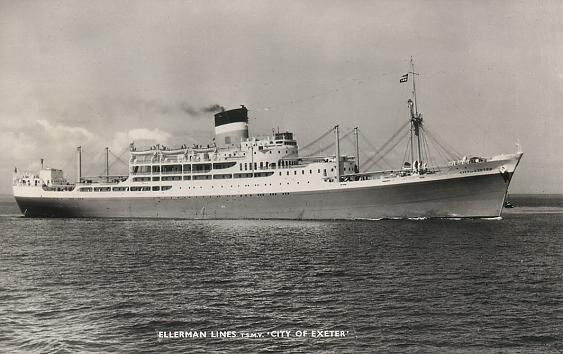
The second of the Quartet departed London for Beira in May 1953, and like her sister enjoyed 18 successful years plying her way to and from to Africa. However, as with most liners services around the world, air travel became more popular, and soon loadings dropped off rapidly. She like her sister City of Port Elizabeth was sold in 1971 to Michael A. Karageorgis, Piraeus in 1971. The City of Exeter was renamed Mediterranean Sea, a name she carried until 1995.
Built: 1952 Vickers Armstong, Newcastle, England
Yard: 121
GRT: 13,343-tons
Launched: 7 July 1952
Completed: 29 April 1953
Length: 164.8m - 541ft
Beam: 21.7m – 71.2ft
Engines: Doxford Type Diesels – 12,650 BHP
Propellers: Twin
Speed: 18.8kn max / 16.5kn service speed
Passengers: 107 - First Class
Later Names: Mediterranean Sea 1971, Tutku 1996, Alice 1996-98
Karageorgis Lines rebuilt her at Perama into an ultra modern Car Ferry, able to take 850 passengers. Her tonnage was now listed as 15,212-tons. She was completed in December 1972 and she commenced the Patras - Brindisi - Ancona service. In 1974 she was registered at Famagusta and was listed as being 16,384-tons. In 1982 she commenced a direct service between Ancona to Patras.
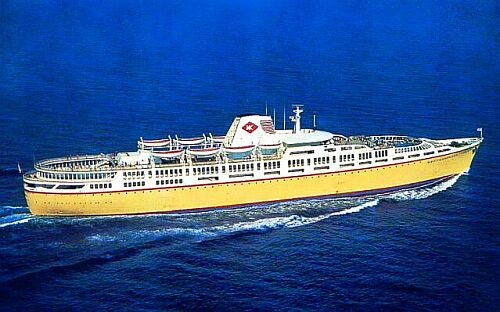
Mediterranean Sea has no semblance of the elegant ship she one was.
In June 1995 Mediterranean Sea was sold to Istanbul Sea Lines S.A., a company with its HQ in Germany. In January 1996, she was transferred to Deep Ocean Shipping, Panama and renamed Tutku. I December that same year she came under the banner of Armon Trading, Piraeus, who renamed her Alice.
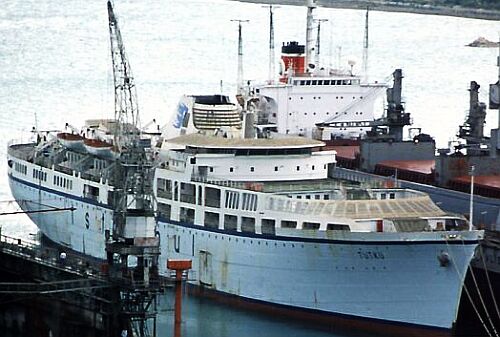
Above Re-named as Tutku.
T.S.M.V. City of York.

City of York departed London in November 1953, and together with her sisters maintained this service until sold to Michael A. Karageorgis, Piraeus in 1971, when she became the Mediterranean Sky. The City of York / Mediterranean Sky, proved to be the most successful of the quartet, remaining in service the longest. Her last voyage was in August 1996, when she sailed from Brindisi to Patras.
Built: 1952 Vickers Armstong, Newcastle, England
Yard: 122
GRT: 13,345-tons
Launched: 30 March 1953
Completed: 26 October 1953
Length: 164.8m - 541ft
Beam: 21.7m – 71.2ft
Engines: Doxford Type Diesels – 12,650 BHP
Propellers: Twin
Speed: 18.8kn max / 16.5kn service speed
Passengers: 107 - First Class
Later Names: Mediterranean Sky 1971

Due to the companies’ financial situation, the Mediterranean Sky was arrested in 1997, whilst in Patras. She remained in Patras until 1999, when she was towed to Eleusis, and laid up and was virtually abandoned. Then, in late November, 2002, she began to take on water and began to list. In order to stop her sinking, she was towed to shallow water and was grounded. In January 2003, Mediterranean Sky keeled over on her side in Eleusus Bay. She remains there awaiting her fate.

Below Mediterranean Sky All dressed up and nowhere to go.
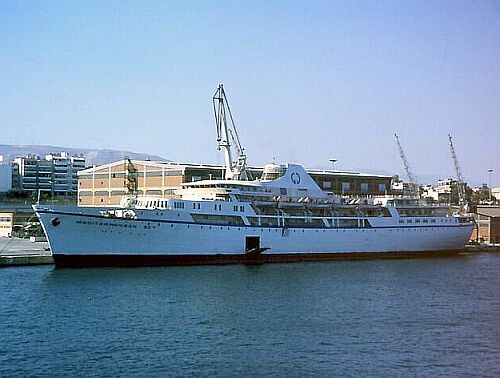
T.S.M.V. City of Durban.
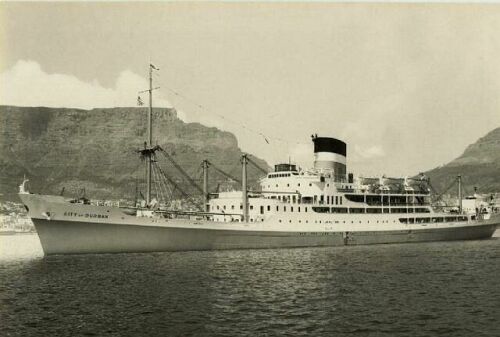
The City of Durban departed London May 1954 and joined her sisters’ successful service to Africa. However, she and her three sisters were sold to Michael A. Karageorgis Group in 1971, when she was renamed Mediterranean Dolphin.
Built: 1953 Vickers Armstong, Newcastle, England
Yard: 123
GRT: 13,345-tons
Launched: 28 May 1953
Completed: May 1954
Length: 164.8m - 541ft
Beam: 21.7m – 71.2ft
Engines: Doxford Type Diesels – 12,650 BHP
Propellers: Twin
Speed: 18.8kn max / 16.5kn service speed
Passengers: 107 - First Class
Later Names: Mediterranean Dolphin 1971.
City of Durban was the last of the series to be built, but sadly, she was the first of the famous Quartet to be scrapped.
City of Durban suffered the same fate as the City of Port of Elizabeth. Although Karageorgis Lines had intentions to convert her and her sister into a car ferry, then later as a luxury cruise ship. They both remained idle. On March 30 1974, Mediterranean Dolphin arrived at Kaohsiung, and was broken up.
Summary.
The “City of Port Elizabeth” class were indeed notable ships, Ellerman’s last deep sea combination-passenger liners, but, many forget that they were the last vessels of their kind to operate from the port of Hull.
After the rebuilding, the transformation of the City of York and the City of Exeter was, to say the least, extreme. Karageorgis turned these graceful ocean liners to futuristic style ferries, which most “salts” will consider as “nothing short of a travesty”!
Today, the sole survivor, City of York / Mediterranean Sky lies on her side at Eleusis Bay, and has been awaiting her fate for the last few years. (Believed to have been scrapped where she lay).
The sad part about the story is that these ships had seen less than twenty years sea service. Air travel has a lot to answer for.
 |